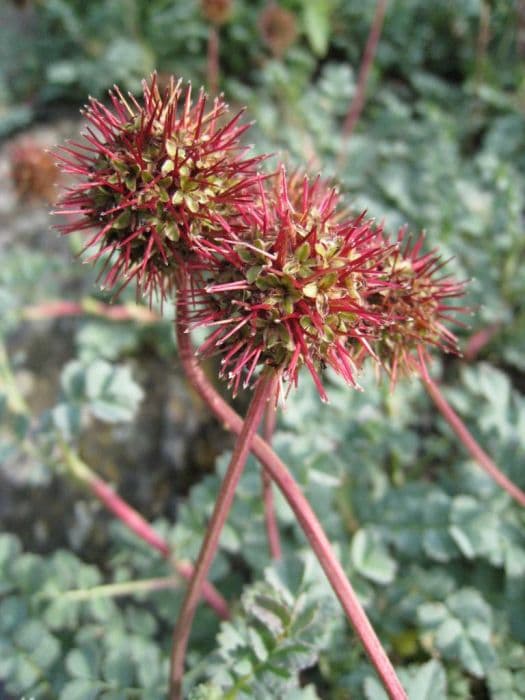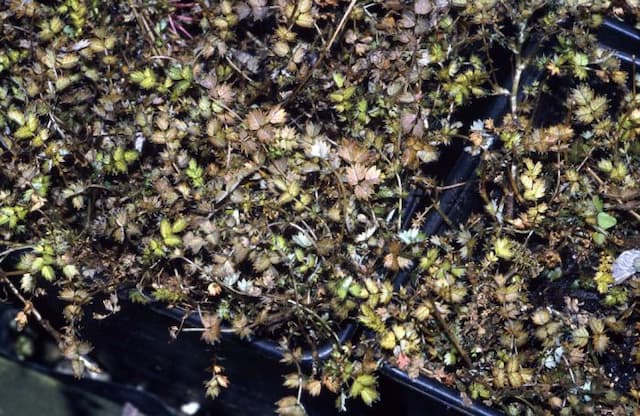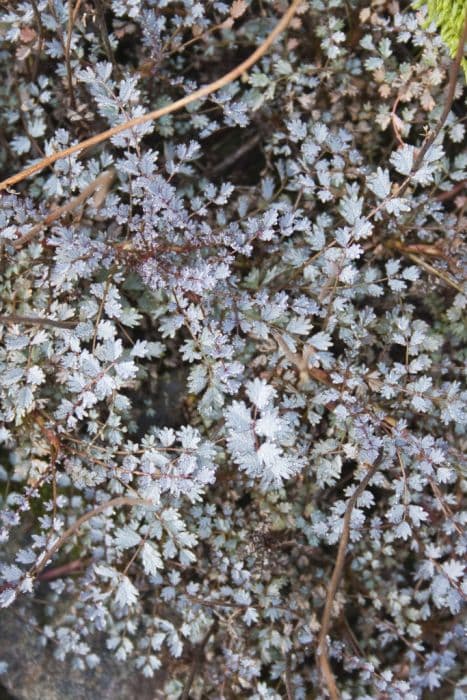Firethorn Pyracantha 'Mohave'

ABOUT
The Pyracantha 'Mohave', also known as Firethorn, is a vibrant evergreen shrub known for its spectacular display of seasonal colors and striking berries. The plant is adorned with small, glossy green leaves that remain throughout the year, offering a constant backdrop for its other showy features. Spring brings a profusion of white flowers, creating a stunning contrast against the deep green foliage. These flowers are not only attractive but also a magnet for various pollinators, adding an element of liveliness to the garden. As the seasons change, the Firethorn produces a profuse amount of bright orange-red berries that cluster along its branches. These berries are small but numerous, creating a dazzling spectacle that persists well into the winter months. As a year-round plant, the Firethorn's evergreen leaves and persistent berries provide lasting interest, especially during the colder seasons when other plants may have lost their leaves or faded into dormancy. The Firethorn has thorny branches that serve as a natural deterrent for animals, making it an effective barrier plant. The thorns, along with the dense growth habit of the shrub, can make it an ideal choice for hedging or for adding security to a landscape. Despite these protective features, the thorns are an integral part of the plant's character, contributing to its rugged yet ornamental appearance. In summary, the Firethorn is a striking, hardy shrub that offers year-round visual appeal with its evergreen foliage, springtime flowers, and abundant, colorful berries. The thorny branches add a distinctive tough texture to the plant, balancing its beauty with a practical defensive characteristic.
About this plant
 Names
NamesFamily
Rosaceae
Synonyms
Mohave Firethorn, Mohave Pyracantha
Common names
Pyracantha 'Mohave'
 Toxicity
ToxicityTo humans
The Pyracantha, also known as Firethorn, contains compounds that can be toxic if ingested. The berry-like pomes may cause irritation if eaten and can lead to gastrointestinal symptoms such as nausea, vomiting, stomach cramps, and diarrhea. Although the berries are the most commonly ingested part, all parts of the plant may contain the irritants. It is advisable to keep Pyracantha out of reach of children who might be tempted to eat the berries. Ingesting large quantities can be more harmful, so seek medical attention if a significant amount has been consumed or if symptoms persist or worsen.
To pets
In pets, the Firethorn can be a source of toxicity if ingested. The plant, including its berries, leaves, and stems, may be irritating to animals and can lead to gastrointestinal upset, which might manifest as vomiting, diarrhea, or abdominal pain. Especially domestic pets like dogs and cats might be attracted to the berries, but they should be discouraged from consuming any part of the plant. If you suspect your pet has ingested Firethorn, it is important to contact a veterinarian to get professional advice tailored to your pet's specific situation.
 Characteristics
CharacteristicsLife cycle
Perennials
Foliage type
Evergreen
Color of leaves
Green
Flower color
White
Height
8-12 feet (2.4-3.7 meters)
Spread
6-9 feet (1.8-2.7 meters)
Plant type
Shrub
Hardiness zones
6-9
Native area
Southeastern Europe to Southwest Asia
Benefits
 General Benefits
General Benefits- Vibrant Berries: Pyracantha 'Mohave' produces bright orange to red berries that add a pop of color to the landscape in fall and winter.
- Evergreen Foliage: This plant retains its foliage year-round, providing constant greenery and structure to gardens.
- Attracts Wildlife: The berries are a food source for birds and small mammals, attracting them to the garden.
- Privacy Screen: Because of its dense growth habit, it can be used as a hedge or screen for privacy or to hide unattractive areas.
- Easy Maintenance: It is relatively easy to care for, requiring minimal upkeep once established.
- Drought Tolerance: Once established, it has a good tolerance for drought, making it suitable for xeriscaping and water-wise gardens.
- Thorny Barrier: The sharp thorns can help deter unwanted visitors and animals, making it a natural security barrier.
- Seasonal Interest: Aside from its berries, Pyracantha 'Mohave' offers seasonal interest with white flowers in spring and vibrant leaves in fall.
 Medical Properties
Medical PropertiesThis plant is not used for medical purposes.
 Air-purifying Qualities
Air-purifying QualitiesThis plant is not specifically known for air purifying qualities.
 Other Uses
Other Uses- Hedge Maze Creation: Pyracantha 'Mohave' can be trained to create intricate maze patterns due to its dense growth, offering an entertaining and challenging garden feature.
- Security Planting: The sharp thorns of this shrub make it an excellent choice for planting beneath windows or along boundaries to deter intruders.
- Topiary Art: It can be pruned and shaped into various forms, making it suitable for topiary art in gardens and landscapes.
- Erosion Control: Pyracantha 'Mohave' has a robust root system that helps stabilize slopes and control erosion in landscapes.
- Noise Reduction: Due to its dense foliage, it can act as a sound barrier when planted in a thick row along busy streets or noisy areas.
- Wildlife Habitat: The thorny branches provide excellent protection for birds, making it an attractive choice for creating wildlife habitats.
- Winter Interest: Its bright orange berries and evergreen foliage add color and interest to otherwise barren winter landscapes.
- Photography Background: Pyracantha 'Mohave' can serve as an ideal backdrop for photographers, especially in autumn when the berries are vibrant.
- Craft Material: The dried berries and branches can be used to create decorative wreaths or arrangements for fall and winter décor.
- Soil Improvement: As the leaves and berries decompose, they contribute to the organic matter of the soil, thereby improving its quality over time.
Interesting Facts
 Feng Shui
Feng ShuiThe Firethorn is not used in Feng Shui practice.
 Zodiac Sign Compitability
Zodiac Sign CompitabilityThe Firethorn is not used in astrology practice.
 Plant Symbolism
Plant Symbolism- Protection: Pyracantha, commonly known as Firethorn, has thorny branches which are often seen as a natural barrier, symbolizing protection and defense against unwanted energies and boundaries.
- Prosperity: The berries of the Firethorn plant are abundant and bright, which can symbolize prosperity and wealth. Their lush appearance suggests fullness and richness in life.
- Strength and Resilience: Firethorn is known for its hardiness and ability to withstand tough conditions, symbolizing strength and resilience in the face of adversity.
- Hope: The vibrant life force of the Firethorn, with its evergreen leaves and resilient nature, can represent hope and the promise of continuity.
- Good Fortune: In some cultures, the bright berries of the Firethorn plant are seen as symbols of good luck and fortune due to their striking appearance.
 Water
WaterFirethorn 'Mohave' should be watered deeply and thoroughly, ensuring that the water reaches the root zone. During the growing season, water the plant about once a week, providing about 1-2 gallons per plant, depending on the size and the weather conditions. During hot, dry spells, you may need to water more frequently. It's important to allow the soil to dry out slightly between waterings to prevent root rot. In the winter months, reduce watering as the plant requires less moisture when dormant. Over-watering can be detrimental, so it's essential to monitor the soil's moisture level.
 Light
LightFirethorn 'Mohave' thrives in full sun to partial shade. The ideal spot for this plant is a location where it can receive at least 6 hours of direct sunlight each day. The more light it gets, the better it will flower and produce berries. However, it can also tolerate some shade, especially during the hottest part of the day, but its flowering may be reduced.
 Temperature
TemperatureFirethorn 'Mohave' is hardy and can tolerate a wide range of temperatures, from as low as -10°F to above 100°F. However, it prefers temperate conditions and grows best when temperatures are between 60°F and 80°F. It's important to shelter the plant from harsh winter winds, especially in the colder end of its hardiness range.
 Pruning
PruningFirethorn 'Mohave' should be pruned to maintain its shape, remove any dead or diseased branches, and encourage the growth of berries. The best time to prune is late winter or early spring before new growth starts. Prune sparingly, as too much can reduce the amount of flowers and berries. Deadheading, or removing spent flowers, is not necessary unless you wish to control the size of the plant or prevent self-seeding.
 Cleaning
CleaningAs needed
 Soil
SoilFirethorn (Pyracantha 'Mohave') thrives best in well-draining soil that is rich in organic matter. A mix consisting of two parts loam, one part peat or compost, and one part sand or perlite is ideal. The pH for Firethorn should be slightly acidic to neutral, ranging from 6.0 to 7.0.
 Repotting
RepottingFirethorn (Pyracantha 'Mohave') does not require frequent repotting and can typically be repotted every 2 to 3 years. It's best to repot in the spring, just before the growing season begins.
 Humidity & Misting
Humidity & MistingFirethorn (Pyracantha 'Mohave') is versatile and can adapt to a range of humidity levels, but it does best with moderate humidity. It can tolerate the humidity levels typically found in most outdoor environments.
 Suitable locations
Suitable locationsIndoor
Provide bright light, prune to shape, and keep soil moist.
Outdoor
Full sun, well-drained soil, water when dry, and mulch.
Hardiness zone
6-9 USDA
 Life cycle
Life cyclePyracantha 'Mohave', commonly known as Mohave Firethorn, begins its life as a seed, which upon germination starts developing into a seedling with basic root structure and foliage. As it grows, it enters the vegetative stage where it focuses on leaf and stem growth, developing a robust branching structure. Upon reaching maturity, the plant will enter the flowering stage, typically in late spring, when it produces white flowers that attract pollinators. Following pollination, the flowers develop into bright orange to red berries in the fall, which remain on the plant through the winter and are a food source for birds. These berries contain seeds that can disperse to produce new plants, completing the cycle. Throughout its life, Mohave Firethorn will experience repeated seasonal growth and dormancy cycles, with active growth in warmer months and dormancy during colder periods.
 Propogation
PropogationPropogation time
Early Spring
The most popular method of propagation for the Firethorn 'Mohave' is through semi-ripe cuttings. This technique involves taking cuttings from the current season's growth in late summer. The cuttings should be 4 to 6 inches (10 to 15 centimeters) long, with the lower leaves removed. To encourage root growth, the base of the cutting is often dipped in rooting hormone powder. The prepared cuttings are then placed in a potting mix that drains well and kept in a warm, humid environment until they root, which usually takes several weeks. It is important to keep the soil moist but not waterlogged to prevent the cuttings from rotting. Once rooted, the new plants can be gradually acclimatized to outdoor conditions before planting out.









